
Before 2020 a conference was an in-person gathering of hundreds or thousands of people and a webinar was an online gathering of dozens to hundreds. 2020 begins the new era of virtual/online conferences. What is the difference?
Conferences serve two main purposes: knowledge sharing and relationship building. The online tools work differently for each of these.
Knowledge Sharing
The creators of conferences spend most of their time fretting over the keynote speakers, panels, and workshops. I know this first hand. I’ve personally programmed a few conferences and dozens of smaller in-person and online events before.
The list of speakers and agenda are what attract first-time attendees to a conference they’ve not attended before. I attended three big virtual conferences in the last month (all of which have been in-person conferences for years) and all three benefited from being online, attracting bigger name speakers and more diverse speakers than have in past.
Little is lost in having these speakers streaming as video instead of speaking live in front of a crowd. In fact I’d say the experience was better online, as many of the plenary talks were polished, pre-recorded videos, which are awkward to watch in a room with 2,000 other people, but totally natural when everything else is delivered by streaming video.
But even better were the panel discussions, as in the virtual conference included a stream of chat from the audience alongside the speakers. At two of the conferences there was a steady second dialog running in every session, with experts and skeptics chiming in to the panel’s conversation, and at times having a second, separate useful conversation for all to see that would have been a small, intimate conversation in the hallway at an in-person conference.
For this aspect of conferences, online is superior.
However, at an in-person conference these planned sessions are only half of the knowledge sharing that happens. What is lost in the virtual version are the conversations that take place in the hallways, over meals, etc. Some of that is captured by the chat stream, but not all.
Relationship building
The other purpose of conferences is building relationships. This comes in a multitude of forms, from purposely designed networking sessions to cocktail parties to happenstance meetings over meals. For those of us who revisit the same in-person conferences year after year, we use the gathering to pre-schedule meetings and enjoy the unplanned, serendipitous meetings that take place in the main conference hall, hallways, and parties.
Very few conference creators put effort into this half of the conference. A few years ago, I helped a big in-person conference better understand their attendees.
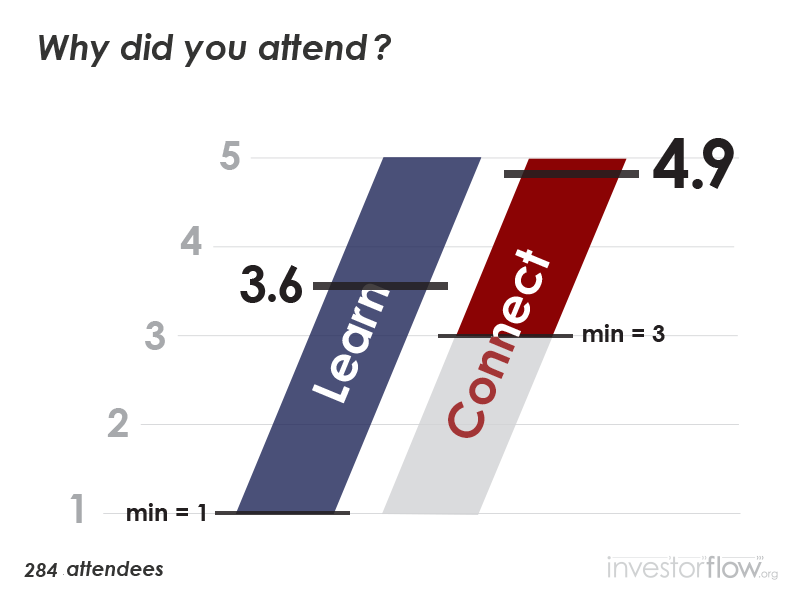
In that survey, on a scale of 1 (low) to 5 (high), “Learn” averaged 3.6 while “Connect” averaged 4.9. Most surprisingly, no one answered Connect as 1 or 2.
From my recent experience, the virtual conference software providers understand the need for connections, but so far their solutions are generously just a 1 out of 5 in terms of uselessness.
Two of the conferences I attended used Hopin. It lets attendees create profiles, shares the list of attendees, and lets any attendee message any other, but the service hid the messages so well that of the 50 I sent out seeking meetings, I received only one reply.
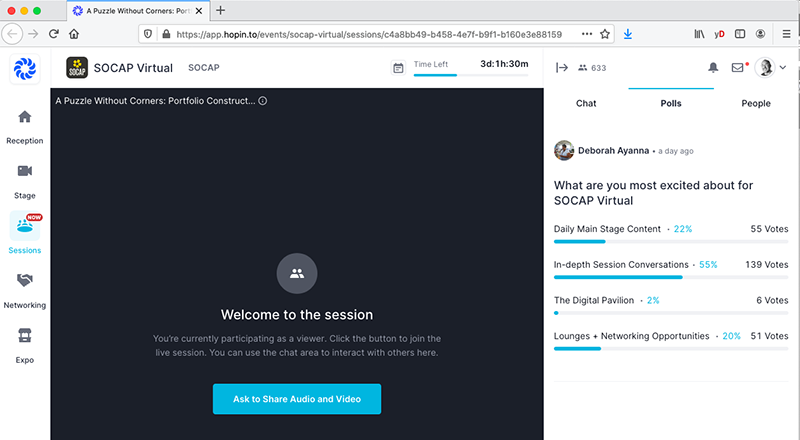
See the tiny red dot next to the envelope? In Hopin that is all that changes when a message arrives. Also note the survey answers. The “Lounges” where SOCAP’s attempt at facilitating networking. I joined most of those sessions and most had just two or three attendees, out of more than 3,000.
The experience on Brella was vastly superior. Look at the screen shot below. Does it take more than a few seconds to notice if there is a message?
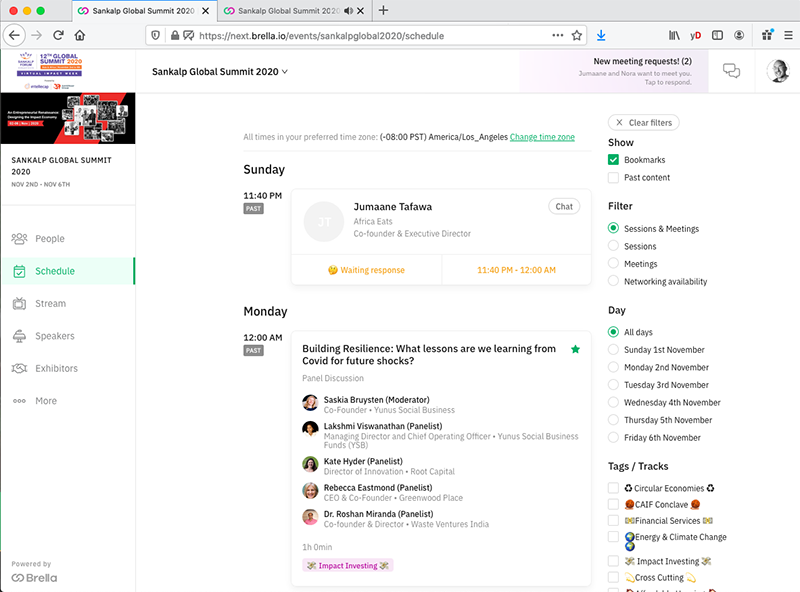
Brella includes the same profiles and list of attendees as Hopin, but oddly doesn’t include any way to chat between attendees. Instead, the Brella experience is centered around 20 minute meetings.
Most excitingly, these meetings are facilitated by matching attendees by interests. When you first login to the conference you are not only asked to fill out your profile, but given the choice of networking. If you agree you fill out a deeper profile with topics set up by the event producer. When you are done you are dropped on a list of attendees best matching your interests, with a bright green button to propose a meeting.
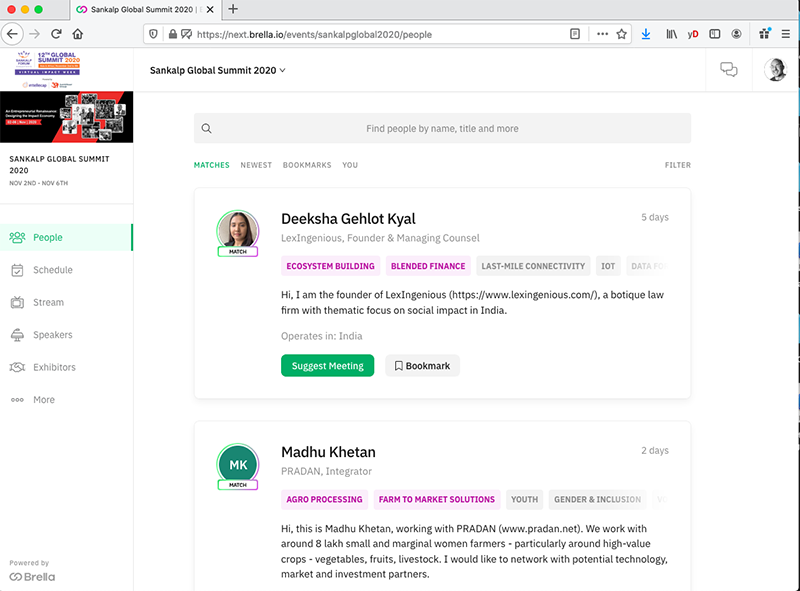
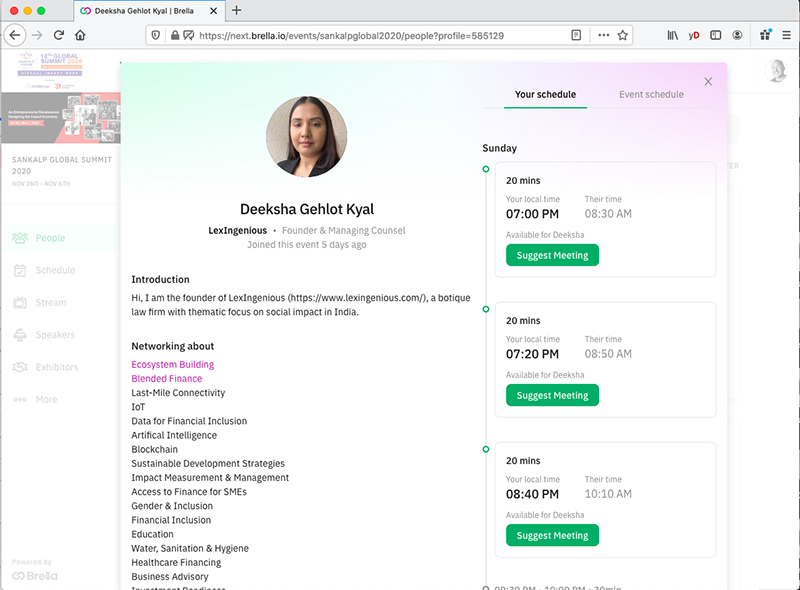
Clicking on the person brings up their profile and a list of times to propose for meetings, with your local time and their local time both visible. This is all integrated with the other sessions, and you can choose whether to block off your calendar during a session or not, per session. You can also block off any 20 minute slot manually, and configure which days you are open to meetings.
Despite all of that, I’d generously rate the service 3 out of 5. Half of the meetings I proposed elicited no reply. Half of the other half were rescheduled. A handful of the last half of half were no-shows.
As I said at the start, I attend these conferences far more for meetings than speakers. At the big in-person conferences, I set up back-to-back 30 minute meetings all day long. At the in-person conferences in the past, most attendees had created their profiles in the two weeks prior to the event. At the virtual conferences, most of the profiles were created after the event began.
I always look through every profile at conferences with attendee lists, so instead of doing that for a few hours a week before the conference, in the last week that became a multi-task while the speakers were speaking.
Serendipity
The biggest missing benefit of in-person conferences missing at virtual conferences is serendipity. Over the years I’ve made great, long-lasting connections with people who happened to be at the same lunch table, whose conversation I heard in a hallway and joined in, at a cocktail party after hours, etc.
The chat stream during the talks isn’t he same as the hallway conversations. Those chats don’t go off on random topics.
None of the events included any after parties. The parties are a key part of networking. I managed to throw two Zoom-based after parties at one conference, but Zoom affords only one conversation at a time, with no easy way for two or three people to break away for their own smaller conversation, and no way to hear your name mentioned across the room and join other people talking about you and your work.
Focus
Lastly, the biggest difference between in-person and virtual conferences is the amount of focus by the attendees. At an all-day or multi-day conference, the attendees top priority is the conference. Yes, plenty of attendees stare at screens during conferences, trying to keep up with work and news, but the attendees wouldn’t both to be at the venue if they didn’t value the conference.
Meanwhile, attendees at virtual conferences are fitting them into their schedules, often flipping back and forth between work and conference.
This is why the messaging at Hopin was so useless. Why there so many no-shows at my Brella meetings. Attendees were attending at all hours of their day, with very few doing nothing but attending session after session interspersed with conference networking and meetings.
That is what I did, but I’m the odd duck who tries to maximize the value from every conference I attend, in-person or virtual, and who spends time looking for ways to create more value from the next instances of these conferences.
Improving the Virtual Conference Experience
I spent the first twenty years of my life designing and building software. Throughout these virtual conferences, as I worked my way through the the user interfaces to maximize my experience, I couldn’t help imagine how to do this better. I expect virtual conferences to be common in the 2020s, even after the pandemic. In my next post, I’ll outline my suggestions for how to vastly improve virtual conferences.













